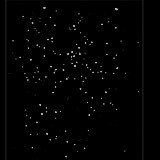
| MESSIER 41 |
|---|
RA: |
06h 46m 00s |
|
DEC: |
-20° 45' 00'' |
|
Type: |
Open Cluster |
|
NGC: |
2287 |
|
Magnitude: |
4.50 |
|
Surface brightness : |
||
Apparent dimensions : |
38'x38' |
|
Distance: |
2,300 ly |
|
Discovered by Giovanni Batista Hodierna before 1654. Perhaps known to Aristotle about 325 B.C. M41 is lying about 4 degrees nearly exactly south of Sirius, the brightest star in the sky. It contains about 100 stars, including several red (or orange) giants, the brightest being of spectral type K3 and mag 6.9, and situated near the cluster's center. This star is about 700 times more luminous than our Sun. The stars are distributed over a volume about 25 or 26 light years across, and all receding from us at 34 km/sec. As they are at a distance of 2,300 light years, they appear scattered over an area of 38 arc minutes diameter. The age of M41 was estimated at 190 million years and 240 million years.The hottest star has been found to be of spectral type A0. All sources agree that it is to be typized as of Trumpler class I,3,r. This stellar swarm is receding from us at 34 km/sec. M41 was possibly recorded by Aristotle about 325 B.C.; this would make it the faintest object recorded in classical antiquity. However, this identification is uncertain. Hodierna was the first to catalog it before 1654, and it got generally known after John Flamsteed's independent rediscovery of February 16, 1702, who remarks (No. 965 in his catalog): "Near this star (12 CMa), there is a cluster." It was independently found again by Le Gentil in 1749, and apparently by Charles Messier, who added it to his catalog on January 16, 1765. This cluster is easy to find, as it is nearly exactly south of Sirius, at an angular distance of 4 degrees. |
||
VEDRAN VRHOVAC© 2006.-2007. |
